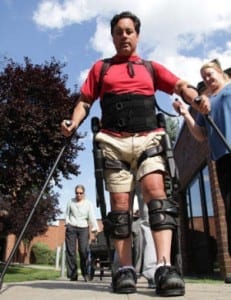
Preliminary Research Findings for Ekso in Spinal Cord Injury – Promising
Preliminary research findings have been released from a clinical study of the wearable robotic exoskeletal device, Ekso (Ekso Bionics). Initial results are promising for the potential application of Ekso-assisted walking in rehabilitation, in exercise/wellness programs, in the community and for home use.
Kessler Foundation has released preliminary research findings from its clinical study of the wearable robotic exoskeletal device, Ekso (Ekso Bionics). Gail Forrest, PhD, assistant director of Human Performance and Engineering Research, presented the Ekso research data on September 3, at the meeting of the Academy of Spinal Cord Injury Professionals at the Rio Suites in Las Vegas. Dr. Forrest directs mobility research at the Foundation, including activity-based locomotor therapy, functional electrical stimulation, and treadmill training with the LokomatPro v6, as well as Ekso. Her research focuses on new ways to improve function and restore mobility for people with disabilities and reduce their long-term risks for complications.
Ekso, has been undergoing clinical investigation in patients with spinal cord injury at Kessler since October 2011, when the research team received the second commercial unit distributed by Ekso Bionics. “Our initial research results are promising for the potential application of Ekso-assisted walking in rehabilitation, in exercise/wellness programs, in the community and for home use,” said Dr. Forrest.
Dr. Forrest not only studies the mechanics of how people with paralysis stand and walk in Ekso, she looks at the impact of these activities on their muscles, hearts and lungs. Long-term studies are needed to evaluate the effects on common secondary complications such as cardiovascular disease, loss of bone and muscle, pressure ulcers, depression, chronic pain, and loss of bladder/bowel control.
Dr. Forrest reported on data collected in 13 patients (12 with paraplegia and 1 with tetraplegia) with spinal cord injury (complete and incomplete injuries) enrolled in the Ekso study. Thus far, walking and standing with Ekso is feasible for people with a range of spinal cord disorders that cause paraplegia. Individuals with higher levels of spinal cord injury may also benefit, but require more time to learn Ekso-assisted walking.
Gait and balance data indicate positive results/progress, ie, for individuals engaging in Ekso-assisted training sessions, walking speed and distance, fluidity, gait and balance improve with training on the exoskeleton. Metabolic and cardiovascular responses were evidenced by increases in oxygen consumption, ventilation and heart rate. These increases occurred with changes from resting to standing position and increased further with changes from standing to walking.
via Science Daily
The Latest Streaming News: Robotic Exoskeletal Device updated minute-by-minute
Bookmark this page and come back often
Latest NEWS
Latest VIDEO







